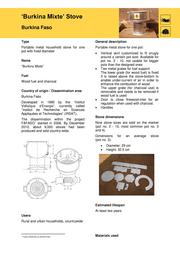Knowledge fuels change - Support energypedia!
For over 10 years, energypedia has been connecting energy experts around the world — helping them share knowledge, learn from each other, and accelerate the global energy transition.
Today, we ask for your support to keep this platform free and accessible to all.
Even a small contribution makes a big difference! If just 10–20% of our 60,000+ monthly visitors donated the equivalent of a cup of coffee — €5 — Energypedia would be fully funded for a whole year.
Is the knowledge you’ve gained through Energypedia this year worth €5 or more?
Your donation keeps the platform running, helps us create new knowledge products, and contributes directly to achieving SDG 7.
Thank you for your support, your donation, big or small, truly matters!
Dual Fuel Stoves
Overview
The “one fuel, one stove, one pot” cooking system is rarely the reality. In many households, there is a variety of pots, stoves, and even fuels in use. There are good reasons for this:
- Different pots: different foods are prepared in different volumes. Frying requires different cutlery than boiling.
- Different fuels: Sometimes fuels are not available all year around. Commercial fuels can only be accessed as long as there is enough cash to procure them. Hence, households tend to switch back to collecting “inferior fuels” once the cash for the month is already spent. Price-hikes of imported fuels (Kerosene, LPG) may force households to go back to wood fuels.
Some dishes are better prepared on firewood. For others, the big open flames from firewood are not wanted and charcoal is preferred for roasting and some types of baking.
- Different Stoves: in some areas, different dishes are prepared at the same time. Sometimes there are smaller and larger stoves to fit different sizes of pots. If a new stove is acquired, the old one is kept as a stand-by. If different fuels are used, it is necessary to have stoves for each fuel.
In areas where households are frequently changing between firewood and charcoal as a fuel for cooking, it is worthwhile to introduce stoves which can be used for both fuels.
Examples are mostly from West-Africa:
- Burkina Mixte:

- Wood-charcoal stoves from stove tec
- Zoom Versa stove from Ecozoom
References
This article was originally published by GIZ HERA. It is basically based on experiences, lessons learned and information gathered by GIZ cook stove projects. You can find more information about the authors and experts of the original “Cooking Energy Compendium” in the Imprint.



















